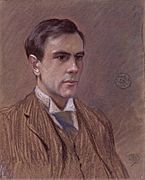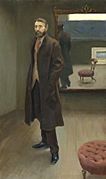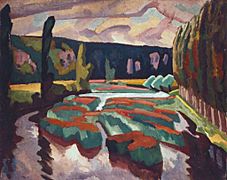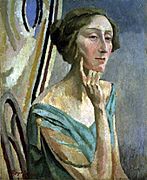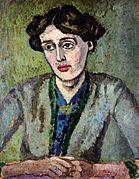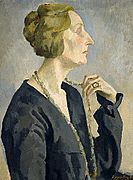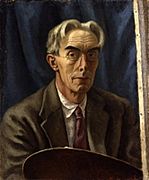Roger Fry facts for kids
Quick facts for kids
Roger Eliot Fry
|
|
|---|---|
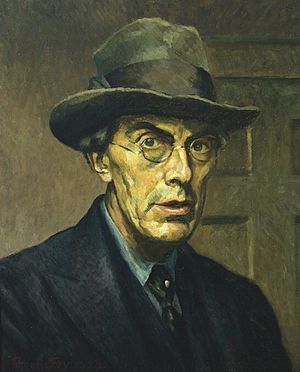
1928 self-portrait
|
|
| Born |
Roger Eliot Fry
14 December 1866 |
| Died | 9 September 1934 (aged 67) Royal Free Hospital, Hampstead, London, England
|
| Nationality | British |
| Education | Clifton College |
| Alma mater | King’s College, Cambridge |
| Occupation | Artist and art critic |
| Known for | Member of the Bloomsbury Group |
Roger Eliot Fry (born December 14, 1866 – died September 9, 1934) was an English painter and art critic. An art critic is someone who writes about and judges art. He was also a member of the Bloomsbury Group, a famous group of writers, artists, and thinkers in England.
Roger Fry first became known for his knowledge of Old Masters (famous artists from earlier times). Later, he became a strong supporter of newer art from France. He even gave this new style a name: Post-Impressionism. He was the first person to help the public in Britain understand and appreciate modern art. He believed that the most important part of a painting was its "formal properties," meaning its shapes, colors, and lines, rather than just what it showed. The art historian Kenneth Clark said that Roger Fry had a huge influence on how people saw art.
Contents
Early Life and Family
Roger Fry was born in London. His father, Edward Fry, was a judge. Roger grew up in a wealthy Quaker family in Highgate. Quakers are a Christian group known for their simple lifestyle and peaceful beliefs.
He had several siblings, including Joan Mary Fry, Agnes Fry, and Margery Fry. Margery later became the head of Somerville College, Oxford, a college at Oxford University.
Roger went to Clifton College and then to King's College, Cambridge. At Cambridge, he was part of a group called the Conversazione Society. This group included many free-thinking men who helped shape his interest in the arts. After studying natural science, he traveled to Paris and Italy to learn more about art. He eventually focused on painting landscapes.
Personal Life
In 1896, Roger Fry married an artist named Helen Coombe. They had two children, Pamela and Julian. Sadly, Helen became very ill, and Roger had to take care of their children with help from his sister, Joan Fry.
In 1910, Roger met the artists Vanessa Bell and her husband, Clive Bell. Through them, he joined the Bloomsbury Group. Vanessa's sister, the famous writer Virginia Woolf, later wrote that Roger "had more knowledge and experience than the rest of us put together."
Roger and Vanessa Bell became very close friends and supported each other. They remained lifelong friends. Later, Roger found happiness with Helen Maitland Anrep, who was a great support to him for the rest of his life.
Roger Fry died unexpectedly after a fall at his home in London. His death made the members of the Bloomsbury Group very sad because they loved his kindness and warmth. Vanessa Bell decorated his casket. His ashes were placed in the vault of Kings College Chapel in Cambridge. Virginia Woolf was asked to write his life story, which was published in 1940.
Artistic Style
As a painter, Roger Fry liked to experiment. Some of his works were even abstract, meaning they didn't show real objects. However, his best paintings were often straightforward portraits of people. He didn't see himself as a professional portrait painter.
In his art, he explored his own feelings and ideas. His work was known for bringing joy and helping people notice unexpected beauty. Roger Fry believed he was "only a serious artist with some sensibility and taste." He thought his painting Cowdray Park was his best work.
Career and Influence
In the early 1900s, Roger Fry began teaching art history at the Slade School of Fine Art in London.
In 1903, he helped start The Burlington Magazine. This was the first important magazine in Britain dedicated to art history. Fry was a co-editor of the magazine for many years and continued to influence it until his death. He wrote over two hundred articles for The Burlington, covering many different art topics. Through his writings, you can see his growing interest in Post-Impressionism.
Roger Fry became very well-known as an art critic for his essays on Post-Impressionist painters. His most important writing about art theory is called An essay in Aesthetics, published in 1920. In this essay, Fry argued that our feelings about art come from its form. This means that the way an artist uses lines, shapes, colors, and overall design is what creates an emotional response. He was very good at seeing what made an artist special.
In 1906, Fry became the Curator of Paintings at the Metropolitan Museum of Art in New York. This was also the year he "discovered" the art of Paul Cézanne. This marked a change in his focus from old Italian masters to modern French art.
Manet and the Post-Impressionists Exhibition
In November 1910, Roger Fry organized a very important art show called 'Manet and the Post-Impressionists' at the Grafton Galleries in London. He even created the term "Post-Impressionism" for this art style. This exhibition was the first to widely show the works of artists like Gauguin, Cézanne, Matisse, and Van Gogh in England.
At first, many people did not like the exhibition. The art was very new and different from what they were used to. Some people even criticized Roger Fry for showing it. However, over time, people began to understand and appreciate Post-Impressionism. This exhibition is now seen as a very important moment for art and culture. Virginia Woolf famously said, "On or about December 1910 human character changed," referring to the big impact this show had. Fry organized a second Post-Impressionist Exhibition in 1912.
Omega Workshops
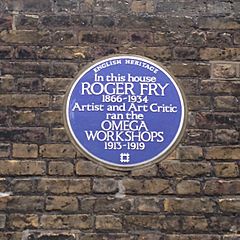
In 1913, Roger Fry started the Omega Workshops. This was a design studio in London where artists, including Vanessa Bell and Duncan Grant from the Bloomsbury Group, created decorative items for homes. All the work made at Omega Workshops was anonymous, meaning it didn't have an artist's name. Instead, everything had the Greek letter Ω (Omega) on it.
They made bold and fun homeware like rugs, ceramics, furniture, and even clothing. Roger Fry wanted to bring a sense of fun into everyday objects. Famous people like Lady Ottoline Morrell and writers like Virginia Woolf, H.G. Wells, and E.M. Forster were clients. The workshops also brought together artists who later formed another art movement called Vorticism. The Omega Workshops stayed open during World War I but closed in 1919.
The Courtauld Gallery has a very important collection of designs and objects made by artists from the Omega Workshops.
Later Career
Roger Fry continued to be a major figure in the art world. In 1925, he helped set up the London Artists' Association. In 1933, he was given the title of Slade Professor at Cambridge University, a position he had always wanted.
He also wrote an important essay on the artist Seurat in 1926. For ten years, he translated poems by the French poet Stephane Mallarmé. Between 1929 and 1934, Roger Fry gave a series of twelve radio talks on the BBC. In these talks, he shared his belief that to appreciate art, you should first focus on its form (how it looks). He argued that an African sculpture or a Chinese vase was just as important to study as a Greek sculpture.
Roger Fry's works can be seen in many famous museums, including Tate Britain, the Ashmolean Museum, and the National Portrait Gallery. His 1928 self-portrait is at the Courtauld Gallery.
A blue plaque was placed on his former home in Fitzroy Square on May 20, 2010, to honor him.
Gallery
-
Edward Carpenter (1894)
-
Edith Sitwell (1915)
-
Virginia Woolf (1917)
-
Edith Sitwell (1918)
Books by Roger Fry
- Art and Commerce (1926)
- Art History as an Academic Study (1933)
- The Artist and Psycho-Analysis (1924)
- Arts of Painting and Sculpture (1932)
- Vision and Design (1920)
- Transformations (1926)
- Cézanne. A Study of His Development (1927)
- Henri Matisse (1930)
- Characteristics of French Art (1932)
- Reflections on British Painting (1934)
- Giovanni Bellini (1899)
- Duncan Grant (1923)
- Flemish Art (1927)
- Last Lectures (1933)
- A Sampler of Castille (1923)
- Twelve Original Woodcuts (1921)
Translations:
- Some poems of Mallarme (1936)
See also
 In Spanish: Roger Fry para niños
In Spanish: Roger Fry para niños


